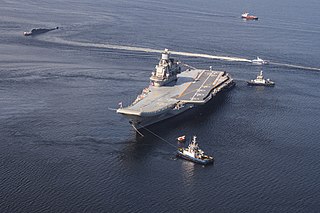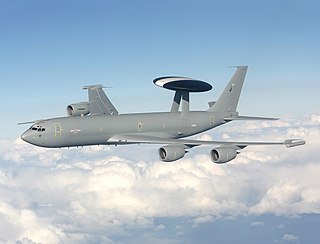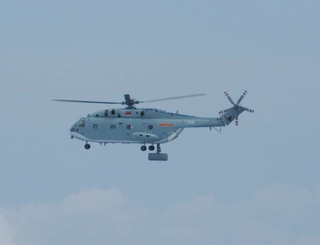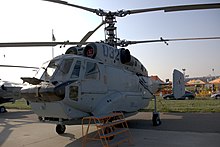
The Kamov Ka-50 "Black Shark", NATO reporting name Hokum A, is a Soviet/Russian single-seat attack helicopter with the distinctive coaxial rotor system of the Kamov design bureau. It was designed in the 1980s and adopted for service in the Russian army in 1995. The Ka-50 is manufactured by the Progress company in Arsenyev. It is used as a heavily armed scout helicopter, and is notable for having a rescue ejection system, rare for helicopters.

The Kamov Ka-25 is a naval helicopter, developed for the Soviet Navy in the USSR from 1958.

Admiral Flota Sovetskogo Soyuza Kuznetsov is an aircraft carrier serving as the flagship of the Russian Navy. It was built by the Black Sea Shipyard, the sole manufacturer of Soviet aircraft carriers, in Nikolayev within the Ukrainian Soviet Socialist Republic and launched in 1985, becoming fully operational in the Russian Navy in 1995. The initial name of the ship was Riga; it was launched as Leonid Brezhnev, embarked on sea trials as Tbilisi, and was finally named Admiral Flota Sovetskogo Soyuza Kuznetsov after Admiral of the Fleet of the Soviet Union Nikolay Gerasimovich Kuznetsov.

The Kuznetsov-class aircraft carrying cruiser, Soviet designation Project 1143.5, is a class of aircraft carriers operated by the Russian and Chinese navies. Originally designed for the Soviet Navy, the Kuznetsov-class ships use a ski-jump to launch high-performance conventional aircraft in a STOBAR configuration. The design represented a major advance in Soviet fleet aviation over the Kiev-class carriers, which could only launch VSTOL aircraft. The Soviet Union's classification for the class was as a heavy aircraft-carrying cruiser, which permits the ships to transit the Turkish Straits without violating the Montreux Convention. However, the Chinese variants are classified as aircraft carriers.

An airborne early warning and control (AEW&C) system is an airborne radar system designed to detect aircraft, ships, vehicles, missiles, and other incoming projectiles at long ranges and perform command and control of the battlespace in an air engagement by directing fighter and attack aircraft strikes. AEW&C units are also used to carry out surveillance, including over ground targets and frequently perform battle management command and control (BMC2). When used at altitude, the radar on the aircraft allows the operators to detect and track targets and distinguish between friendly and hostile aircraft much farther away than a similar ground-based radar. Like a ground-based radar, it can be detected by opposing forces, but because of its mobility and extended sensor range, it is much less vulnerable to counter-attacks.

The Sukhoi Su-33 is a Soviet/Russian all-weather carrier-based twin-engine air superiority fighter designed by Sukhoi and manufactured by Komsomolsk-on-Amur Aircraft Production Association, derived from the Su-27 and initially known as the Su-27K. Compared with the Su-27, the Su-33 has a strengthened undercarriage and structure, folding wings and stabilators, all for carrier operations. The Su-33 has canards, and its wings are larger than the Su-27 for a slower stall speed. The Su-33 has upgraded engines and a twin nose wheel, and is air refuelable.

Ulyanovsk, Soviet designation Project 1143.7, was a fixed-wing aircraft carrier laid down on 25 November 1988 as the first of a class of Soviet nuclear-powered supercarriers. It was intended for the first time to offer true blue water naval aviation capability for the Soviet Navy. The ship would have been equipped with steam catapults that could launch fully loaded aircraft, representing a major advance over the Kuznetsov class, which could only launch less-loaded aircraft from their ski-jumps. However, construction of Ulyanovsk was stopped at about 40% after the dissolution of the Soviet Union in 1991.

The Kamov Ka-22 Vintokryl was a rotorcraft developed by Kamov for the Soviet Air Force. The experimental transport aircraft combined the capabilities of a helicopter for vertical take-off and landing with those of a fixed-wing aircraft for cruise. The Ka-22 carried a large payload, having a hold comparable in size to the Antonov An-12. Eight world records for altitude and speed were set by the Ka-22 in its class, none of which have since been broken.

Soviet Naval Aviation was the naval aviation arm of the Soviet Navy.

The Kamov Ka-27 is a military helicopter developed for the Soviet Navy, and currently in service in various countries including Russia, Ukraine, Vietnam, China, South Korea, and India. Variants include the Ka-29 assault transport, the Ka-28 downgraded export version, and the Ka-32 for civilian use.

Baku was a Kiev-class aircraft carrier of the Soviet Navy and the Russian Navy from 1987 to 1996. In 1991 the ship was renamed Admiral Flota Sovetskogo Soyuza Gorshkov in Russian service.

The Kamov Ka-10 was a Soviet single-seat observation helicopter that first flew in 1949.
The Yakovlev Yak-44 was a proposed twin-turboprop Airborne Early Warning (AEW) aircraft, resembling the United States Navy's E-2 Hawkeye, intended for use with the Soviet Navy's Ulyanovsk class supercarriers. Along with the aircraft carrier it would have flown from, the Yak-44 was cancelled after the demise of the Soviet Union. A full-scale mockup with foldable wings was built.

The People's Liberation Army Naval Air Force is the naval aviation branch of the People's Liberation Army Navy.

Command of the sea is a naval military concept regarding the strength of a particular navy to a specific naval area it controls. A navy has command of the sea when it is so strong that its rivals cannot attack it directly. This dominance may apply to its surrounding waters or may extend far into the oceans, meaning the country has a blue-water navy. It is the naval equivalent of air supremacy.

INS Vikramaditya is a modified Kiev-class aircraft carrier and the flagship of the Indian Navy. Entered into service in 2013.
The Indian Naval Air Arm is the aviation branch and a fighting arm of the Indian Navy which is tasked to provide an aircraft carrier based strike capability, fleet air defence, maritime reconnaissance, and anti-submarine warfare.

The Ugra class was the NATO reporting name for a group of seven submarine tenders built for the Soviet Navy in the late 1960s. The Soviet designation was Project 1886. One further ship was built for the Indian Navy to a modified design. The ships were intended to provide afloat support for Soviet submarines, including supplies, water, torpedoes, fuel, and battery charging; minimal repair facilities, and were often employed as flagships/command ships for submarine squadrons. A subclass, the Borodino class, of two ships were constructed for use as training ships and lacked missiles and the ability to support submarines. Instead, the Borodino class had classrooms and training facilities.

The Changhe Z-18, also known as Z-8G, is a medium-lift transport helicopter developed by Changhe Aircraft Industries Corporation (CAIC) to replace the Changhe/Harbin Z-8.
The INAS 333 is an Indian naval air squadron based at INS Dega, Visakhapatnam.



















